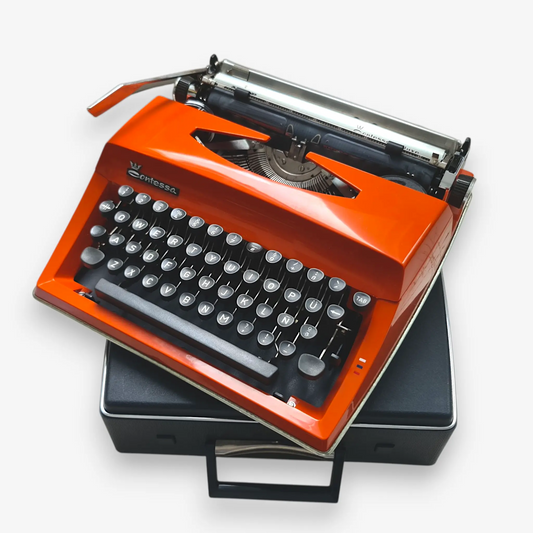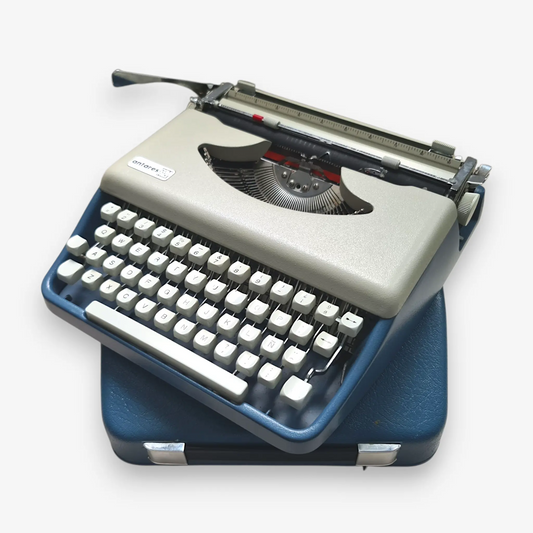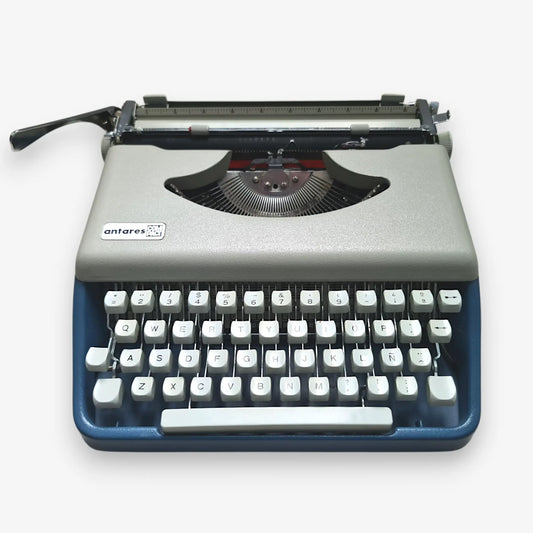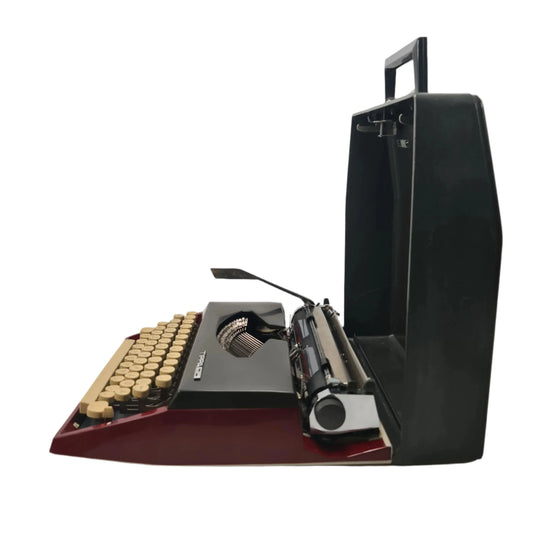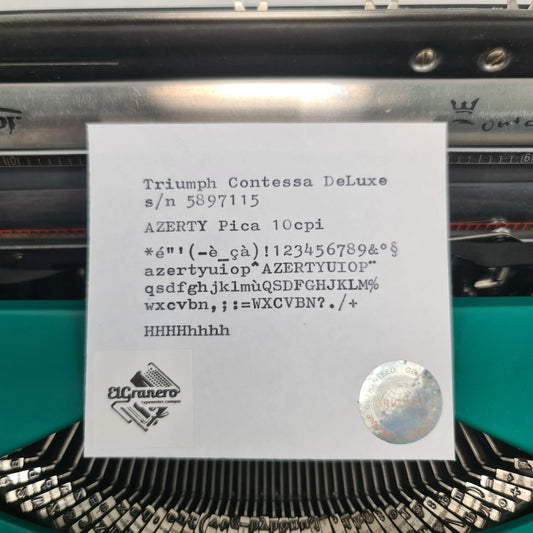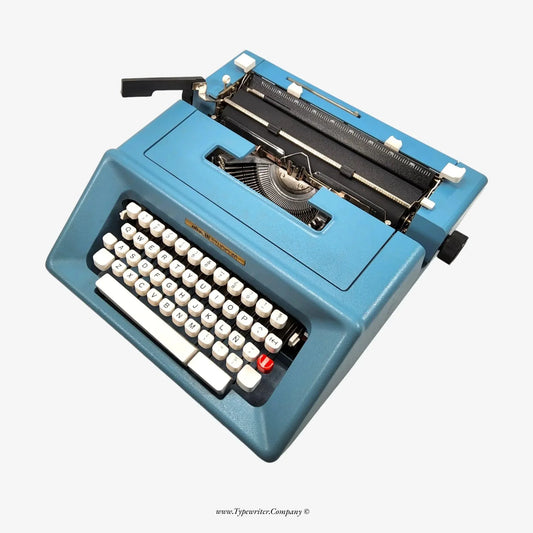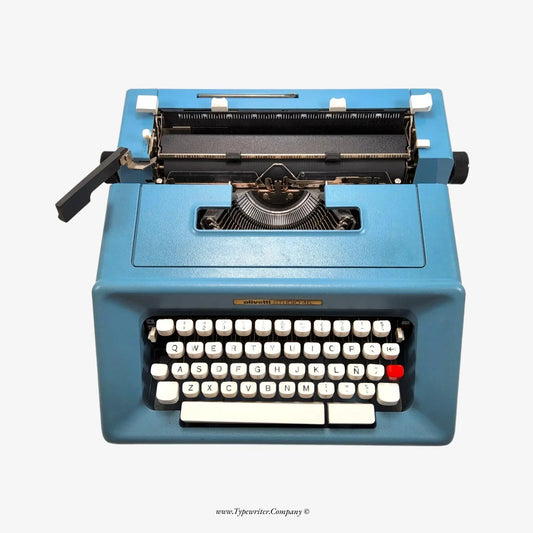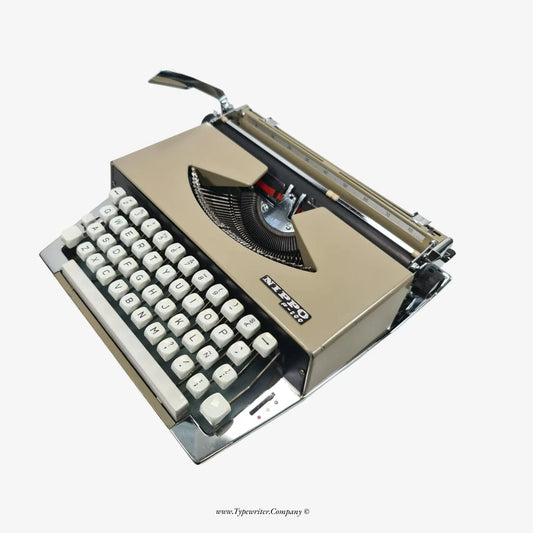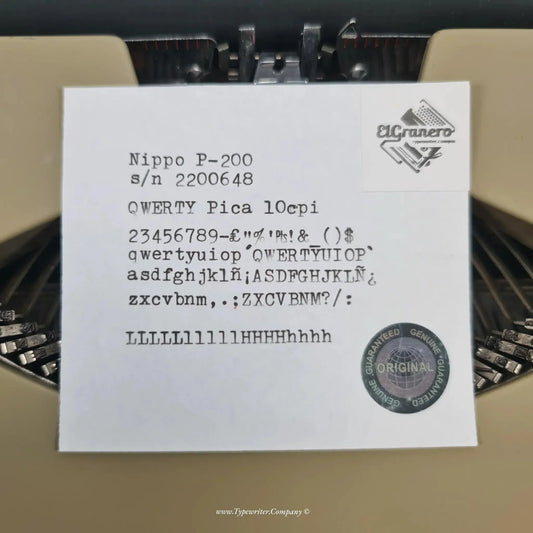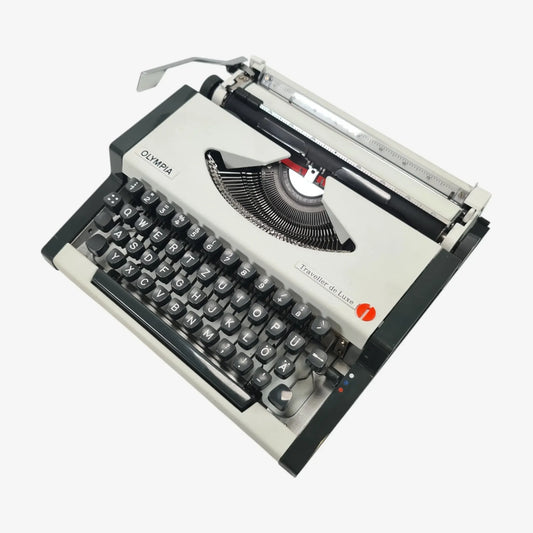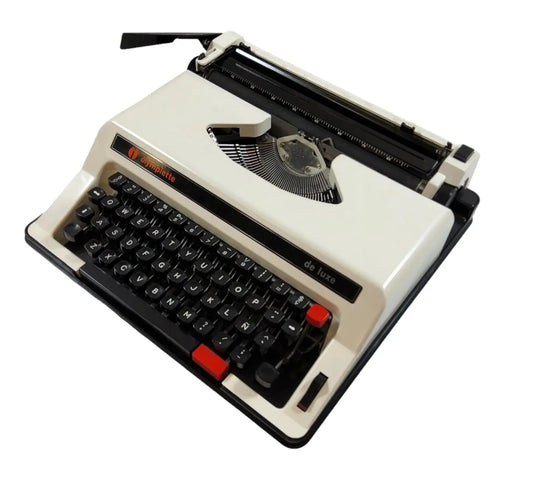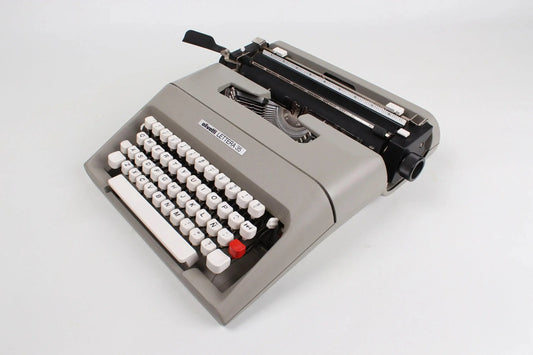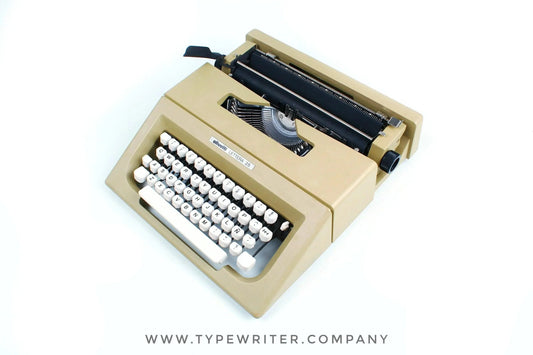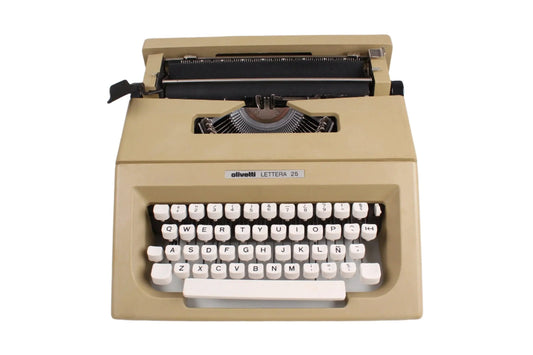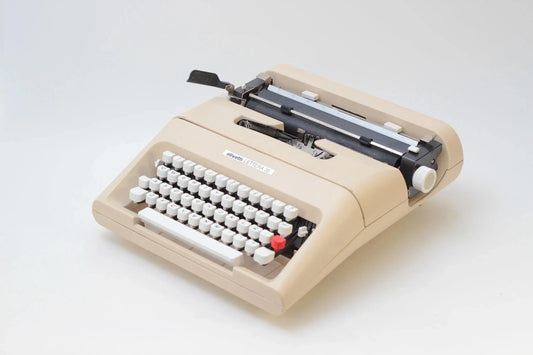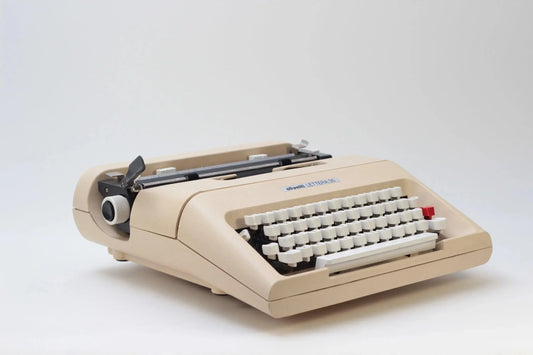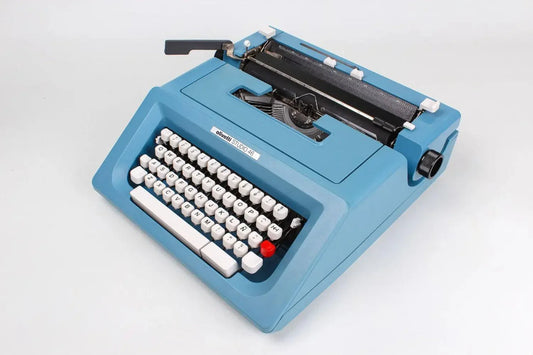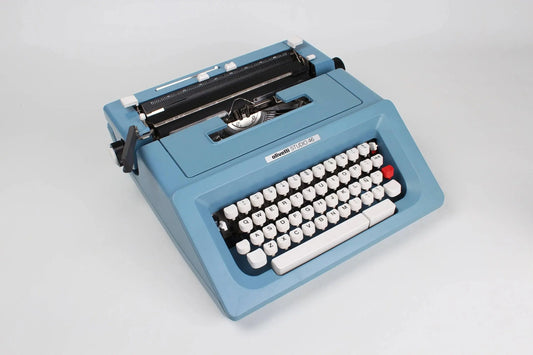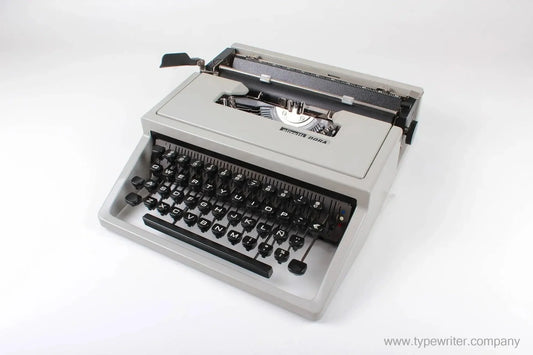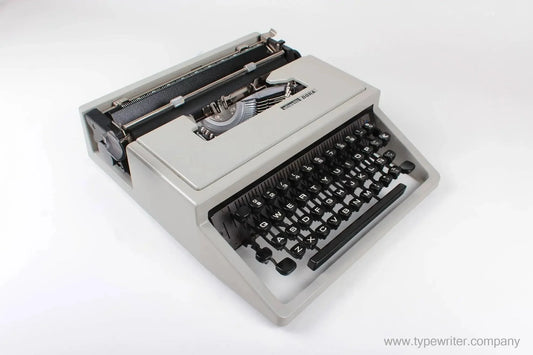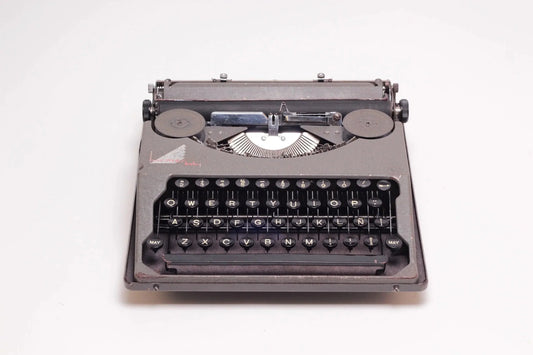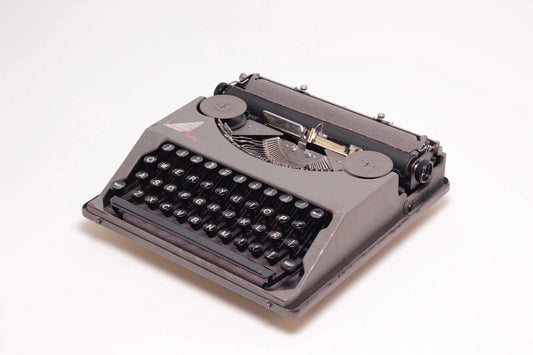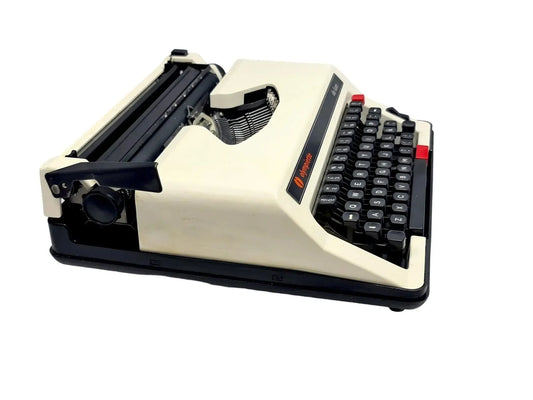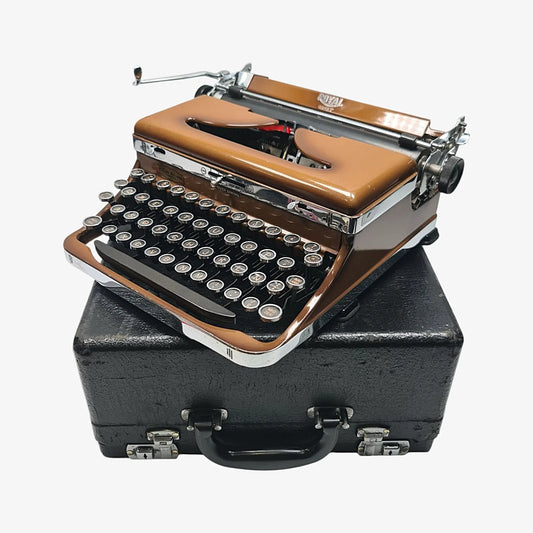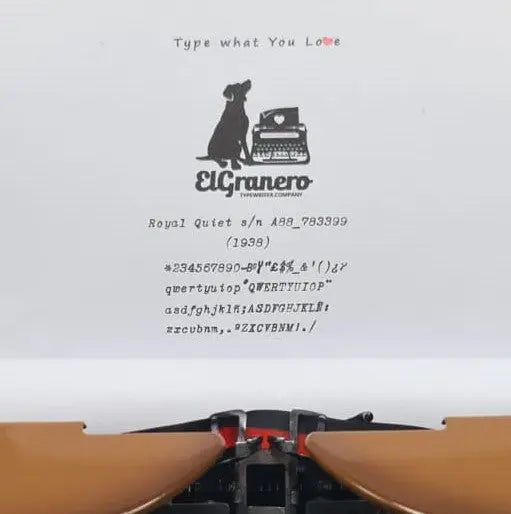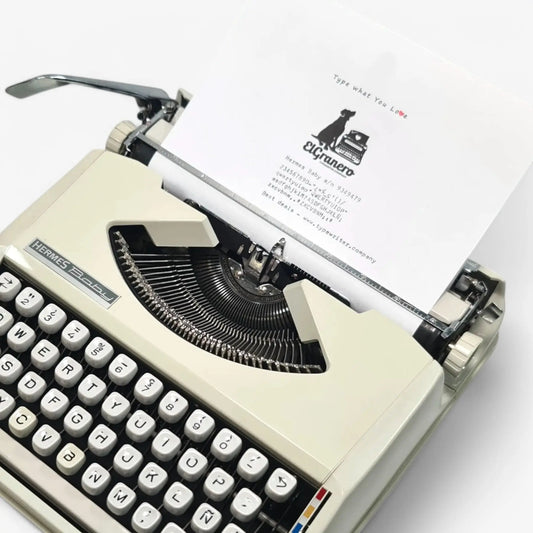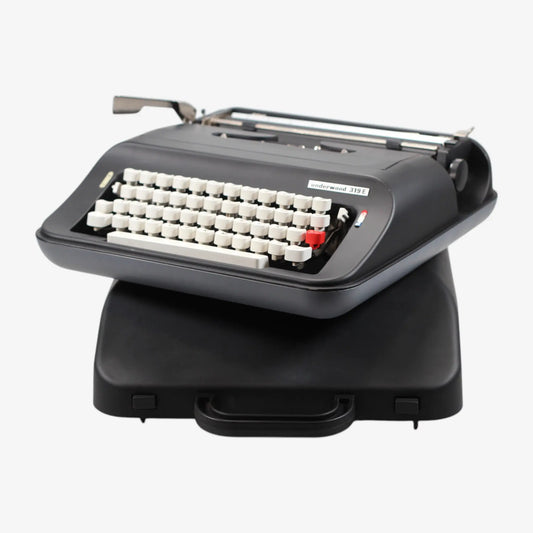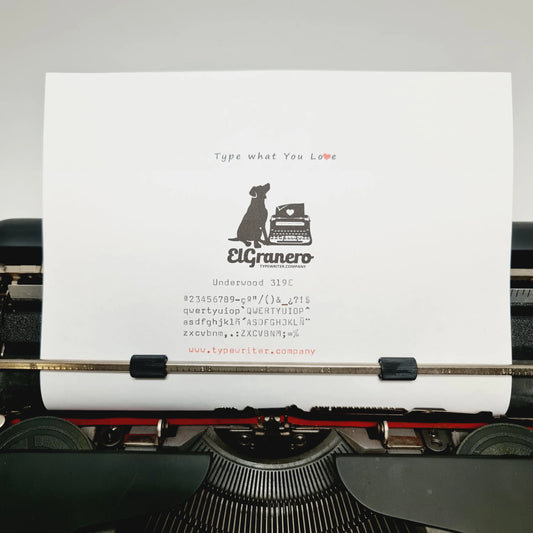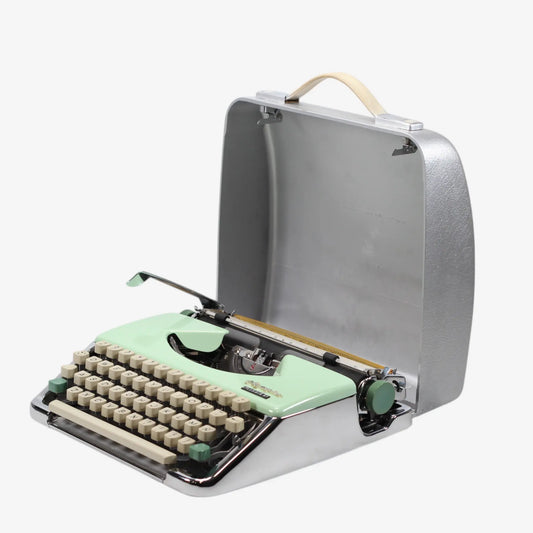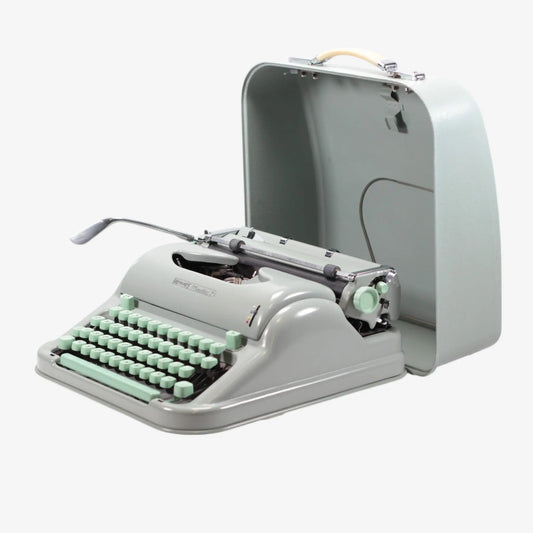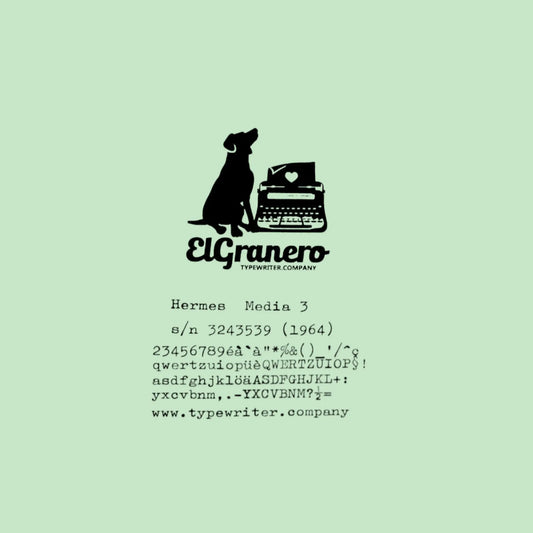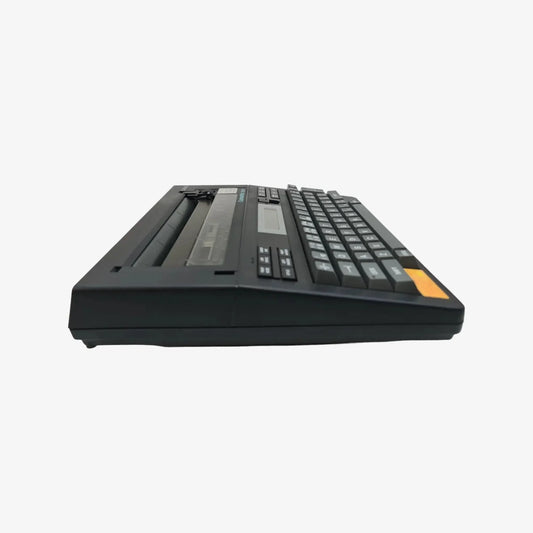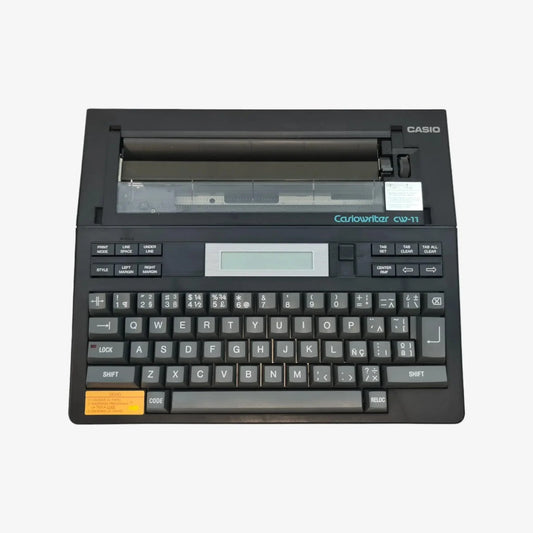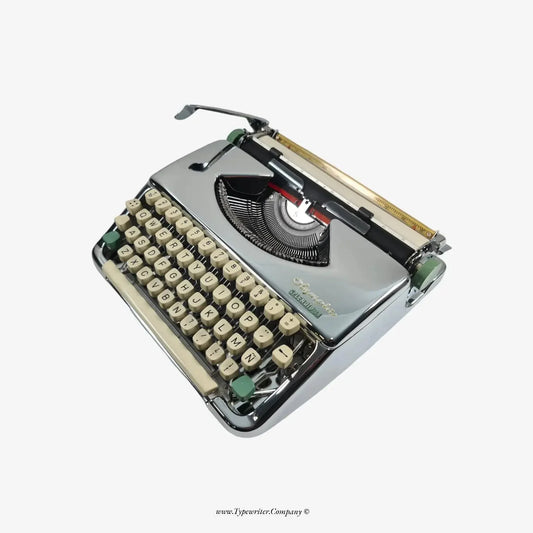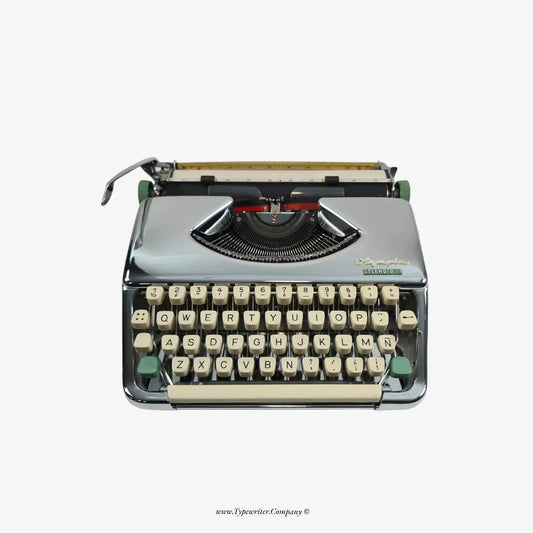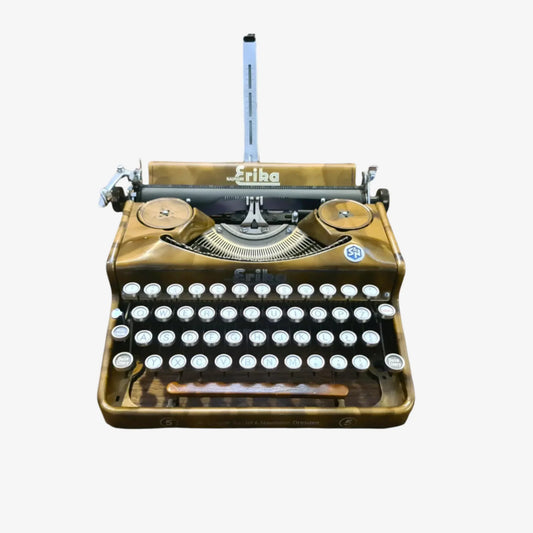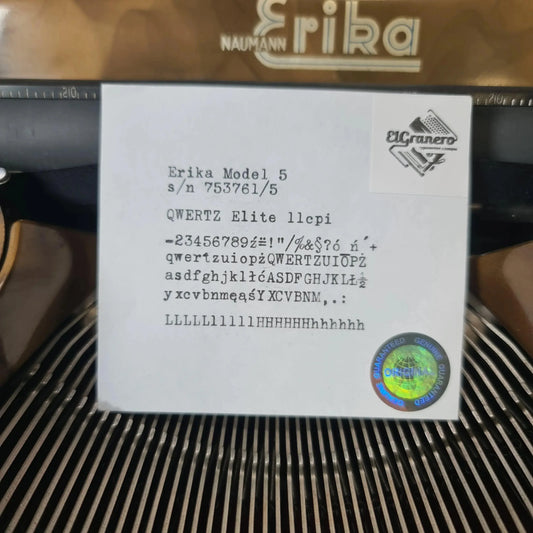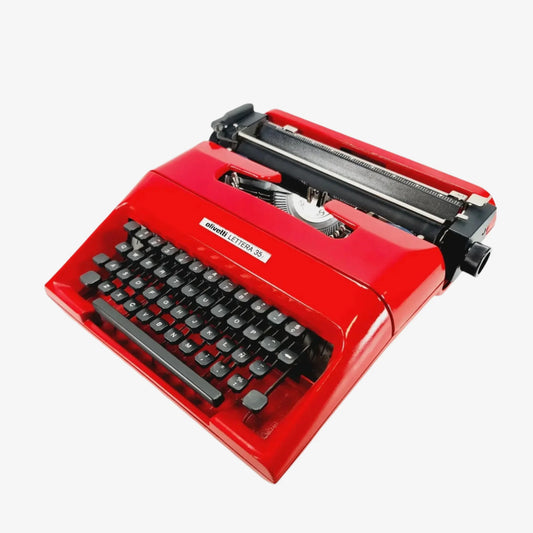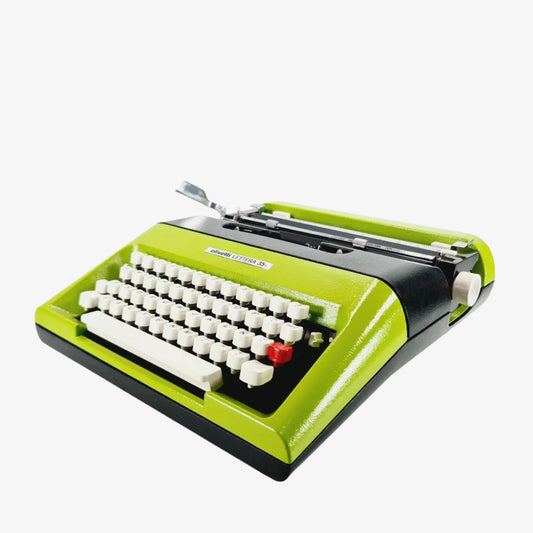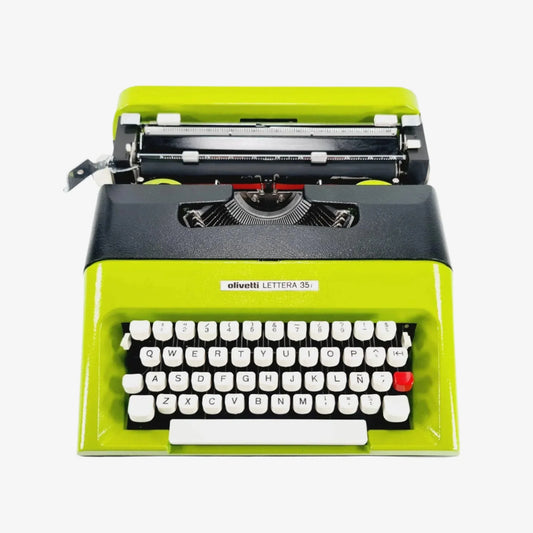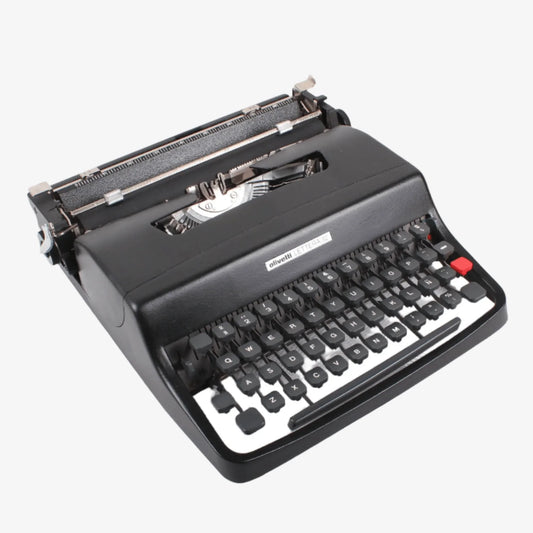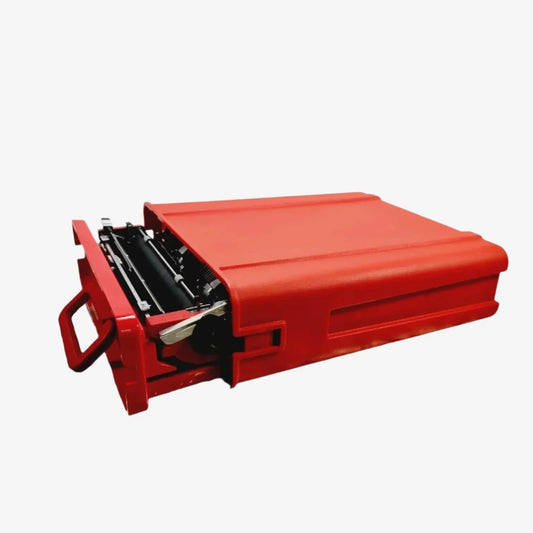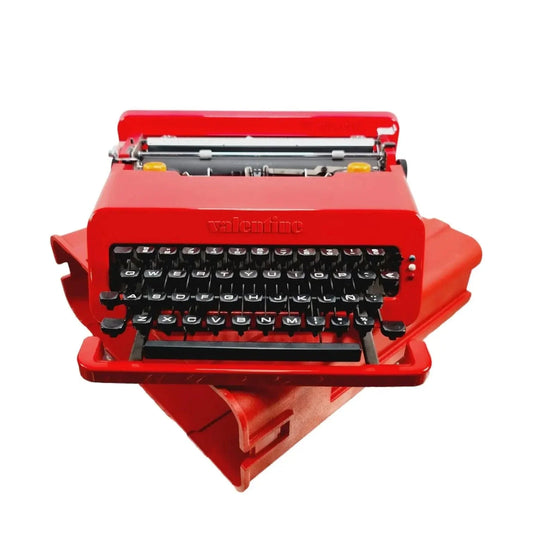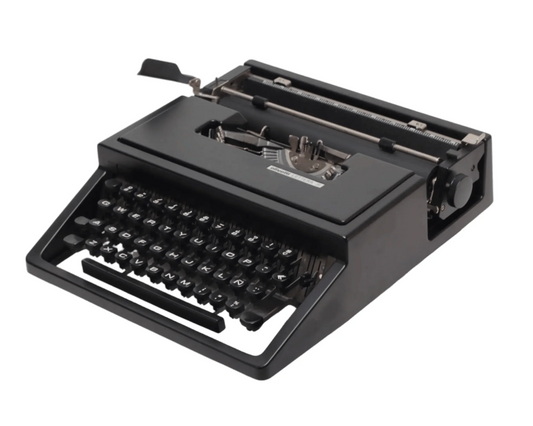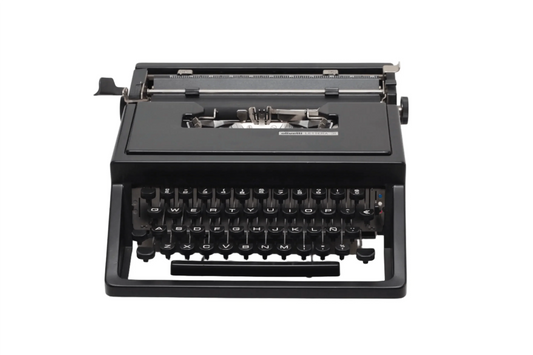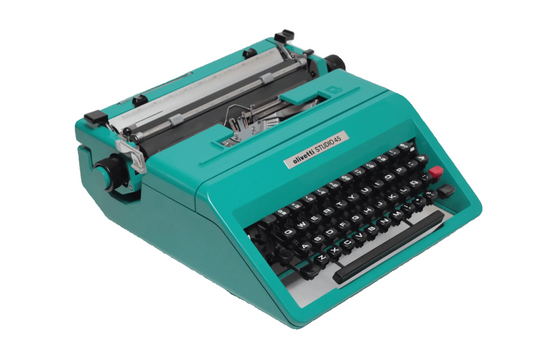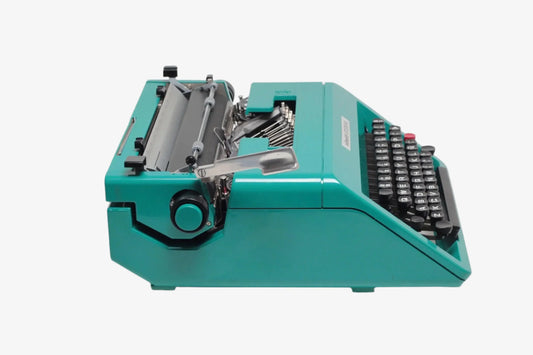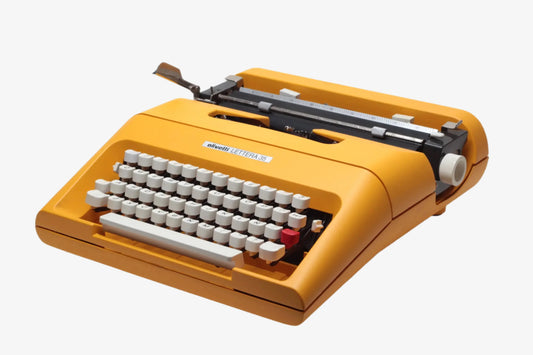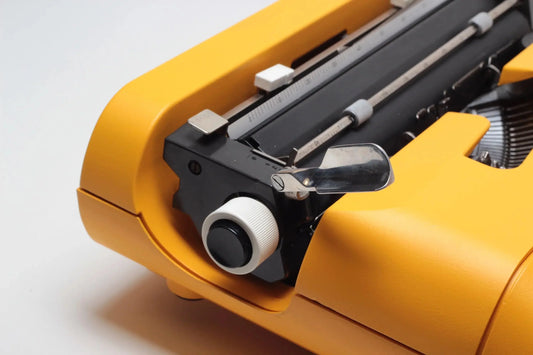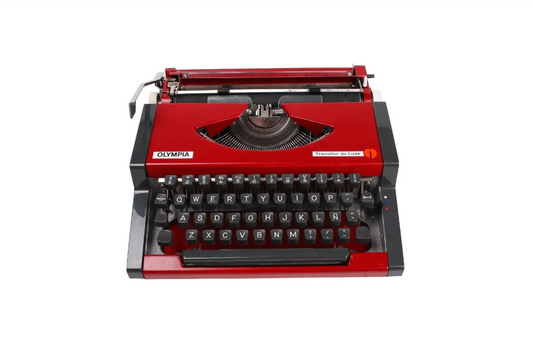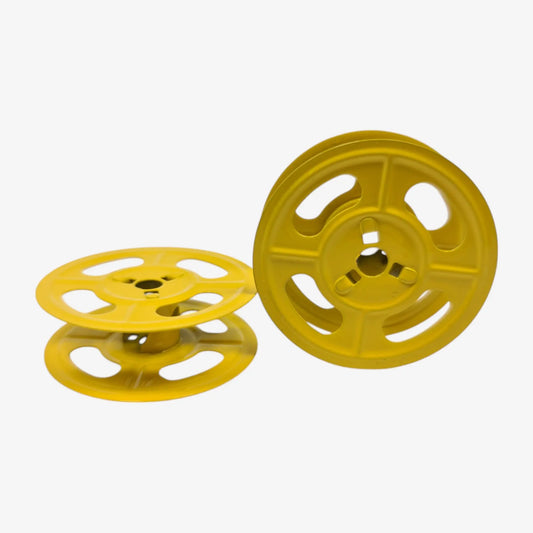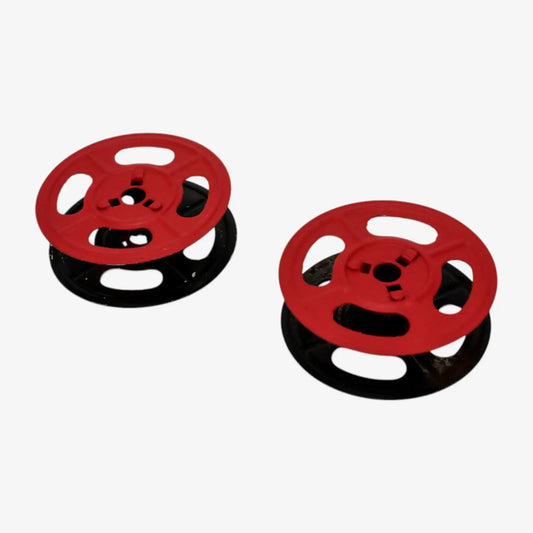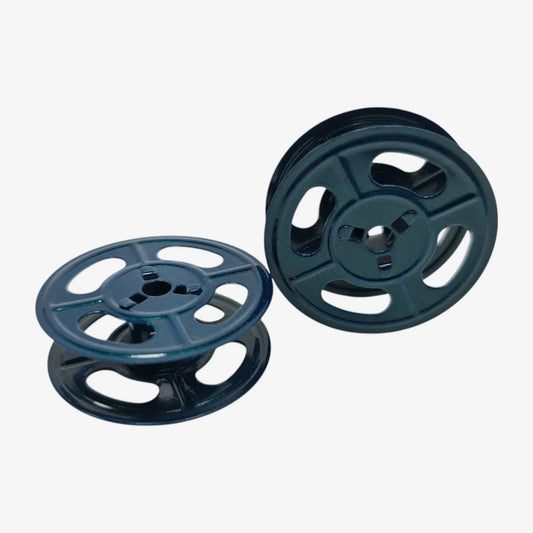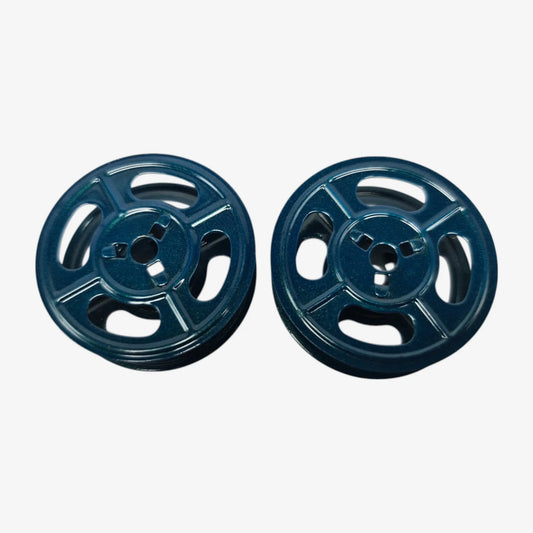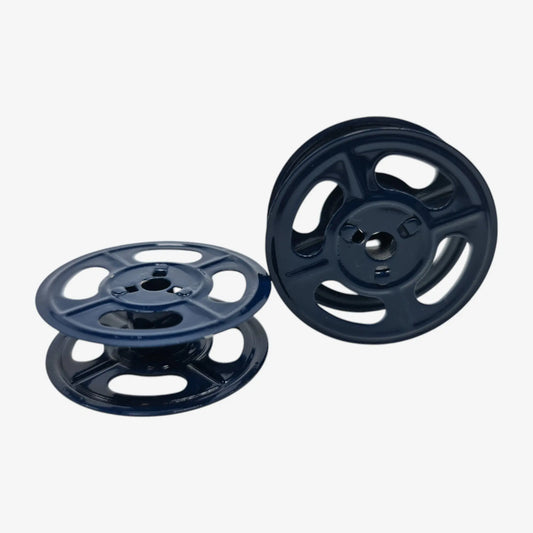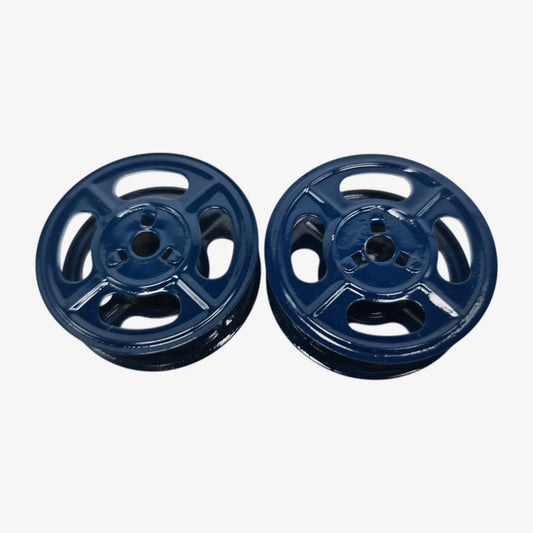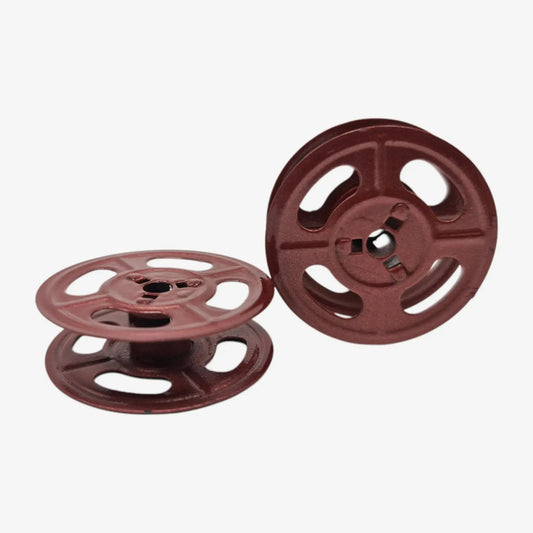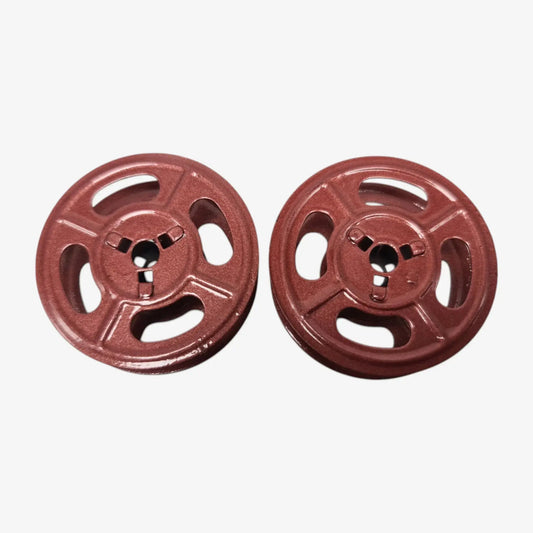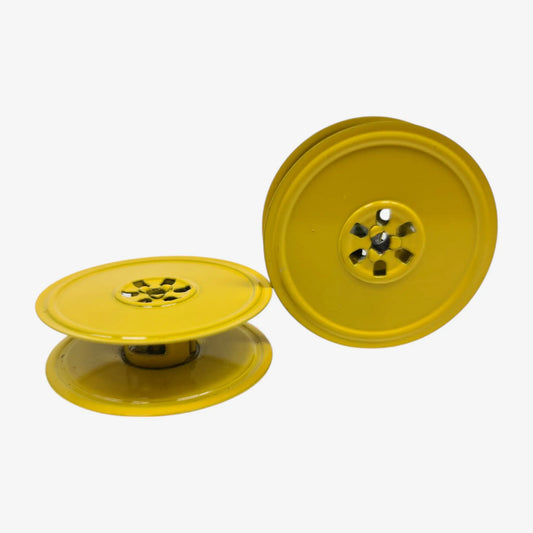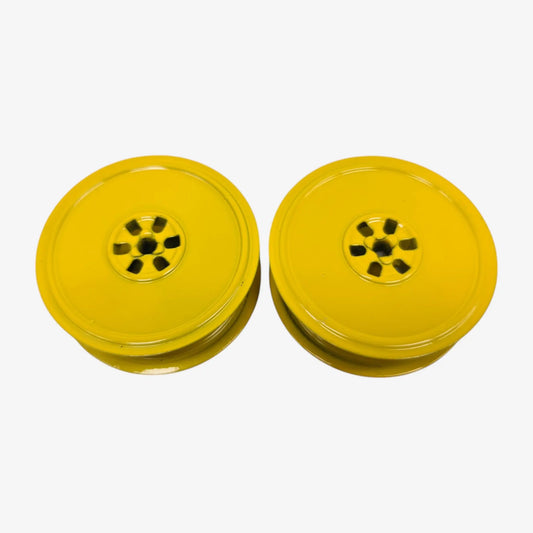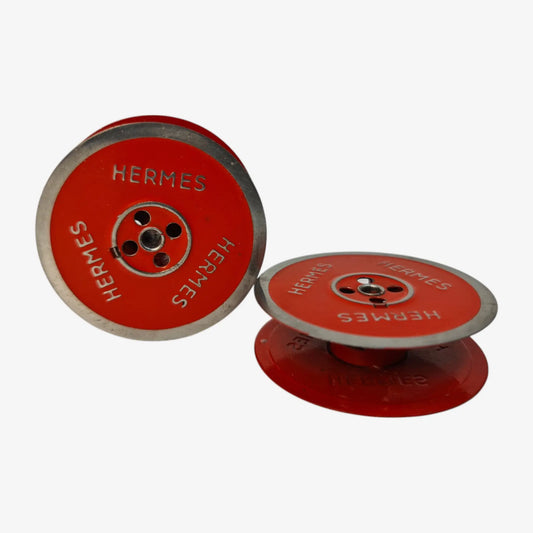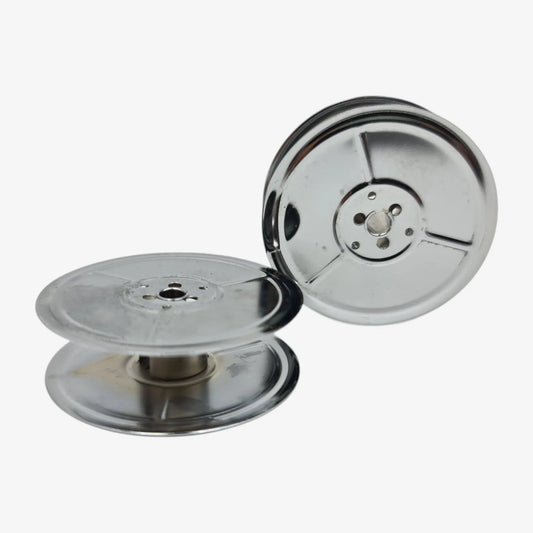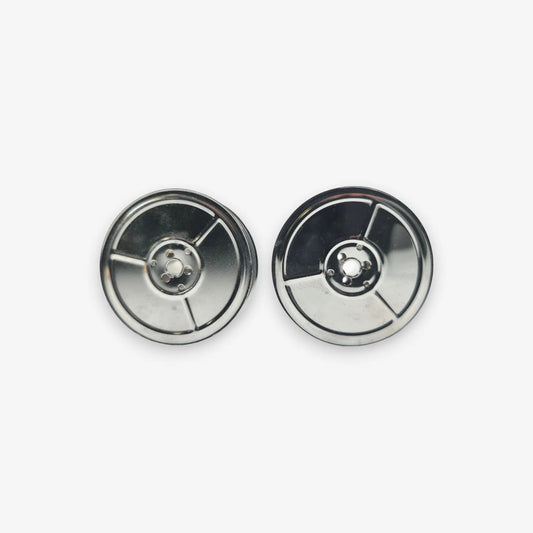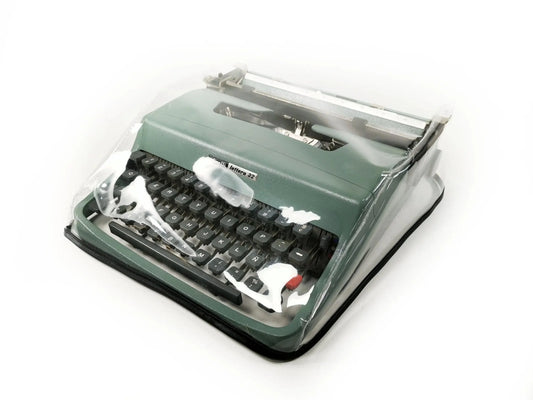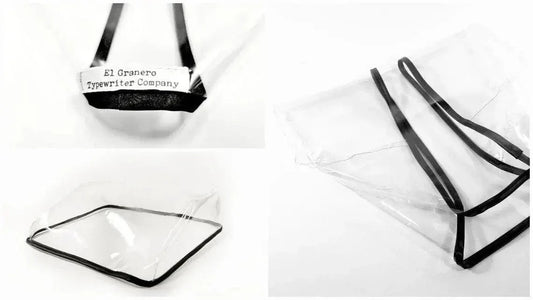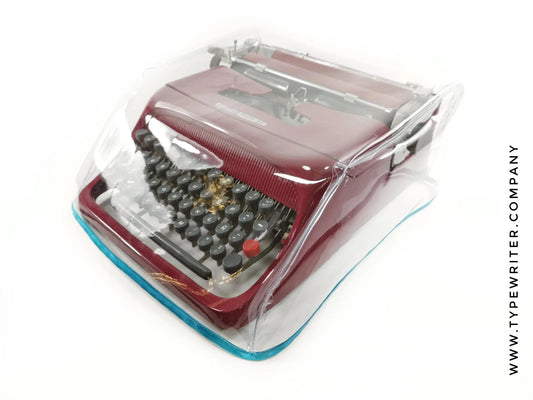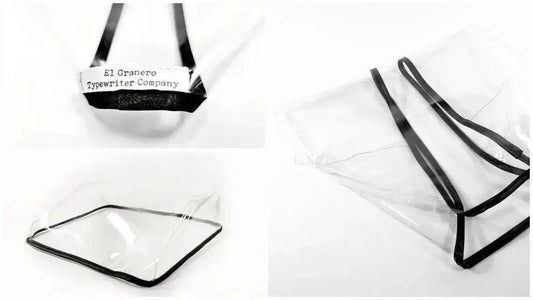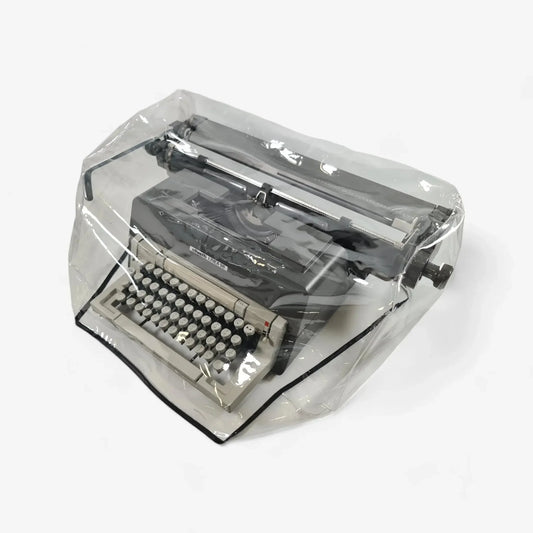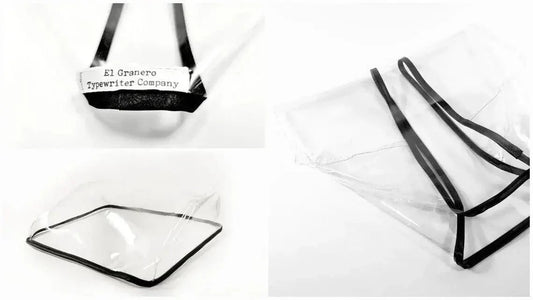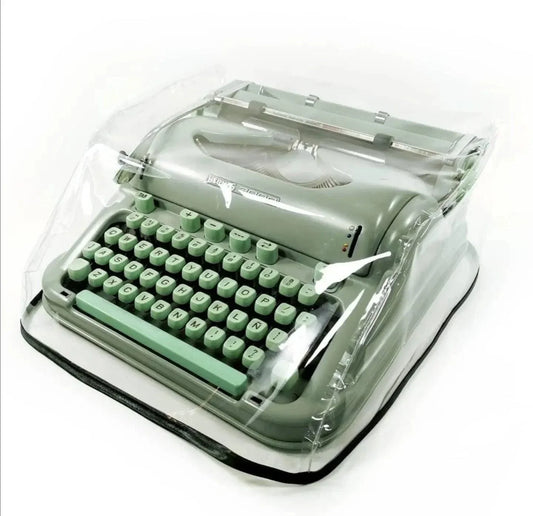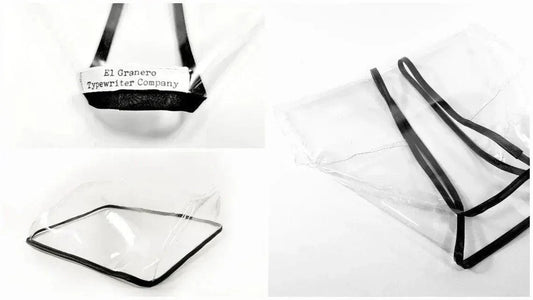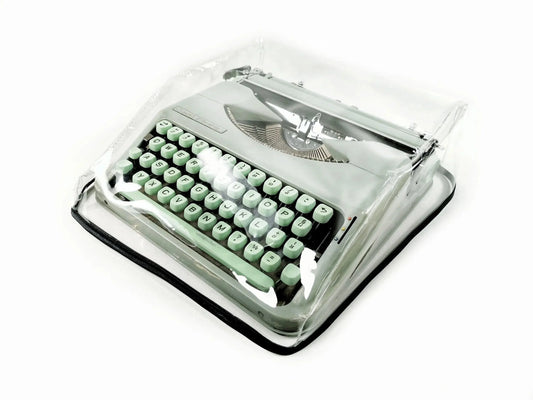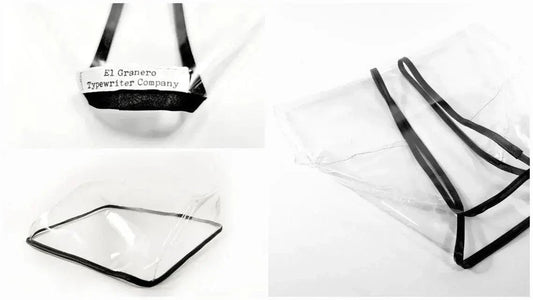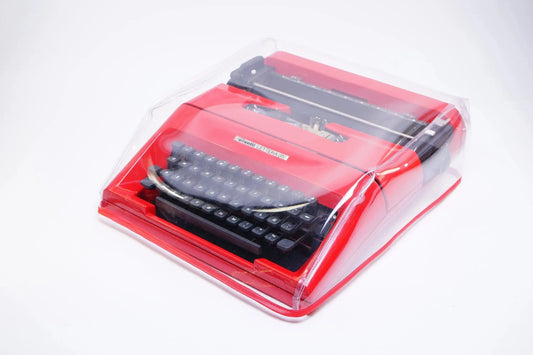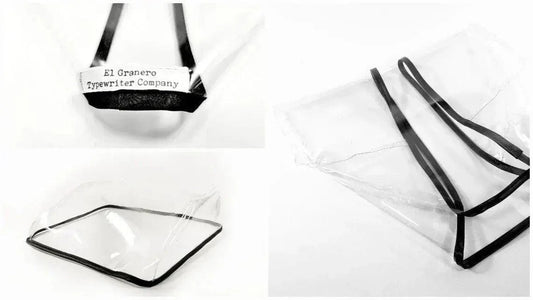
Explore Vintage Restored Typewriters, Accessories, & Unique Gifts
View all-

PORTABLE TYPEWRITERS
Portable Typewriters Explore our collection of vintage portable typewriters, each meticulously restored...
-
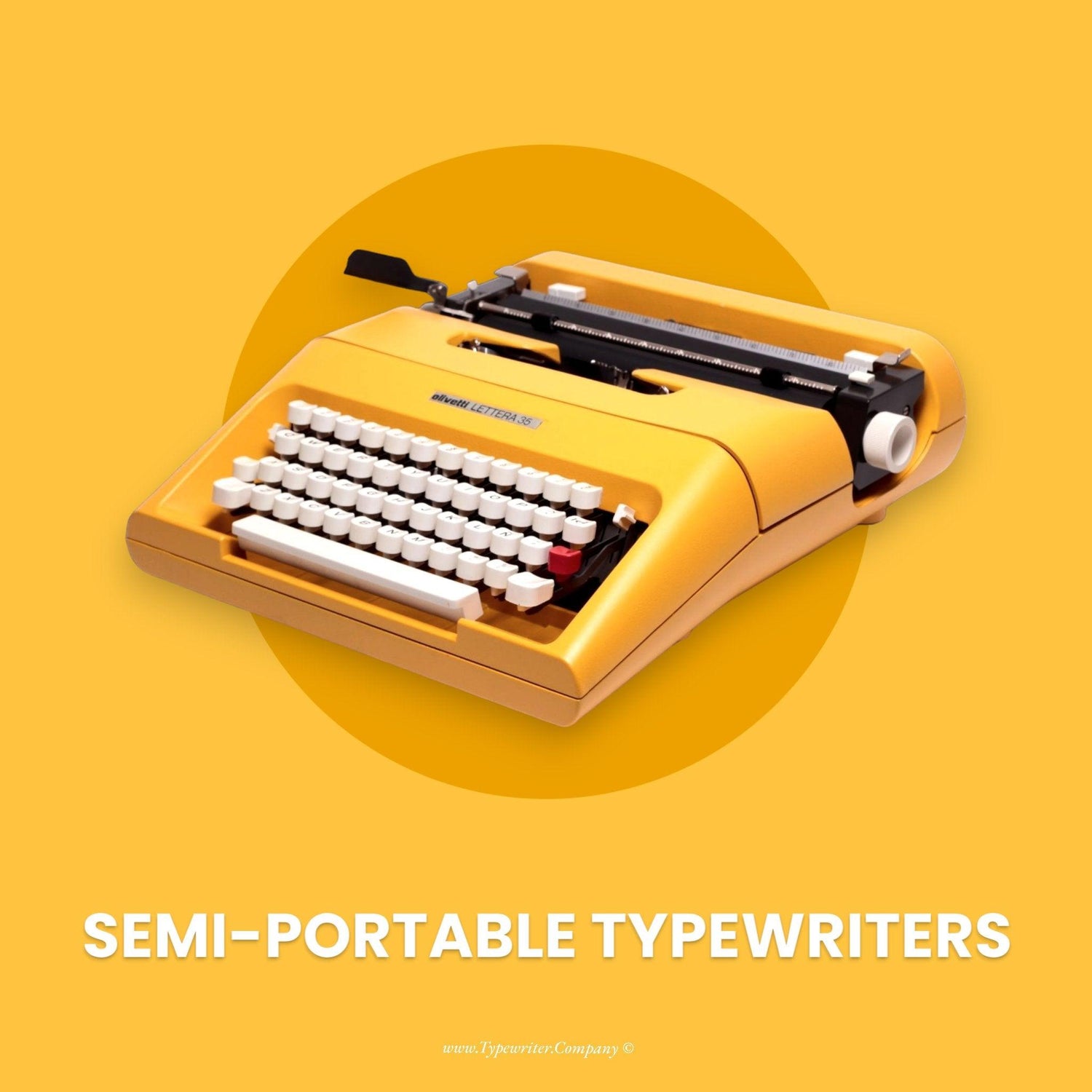
SEMI-PORTABLE TYPEWRITERS
Semi-Portable Typewriters Semi-portable typewriters blend the portability o pmf compact models with...
-
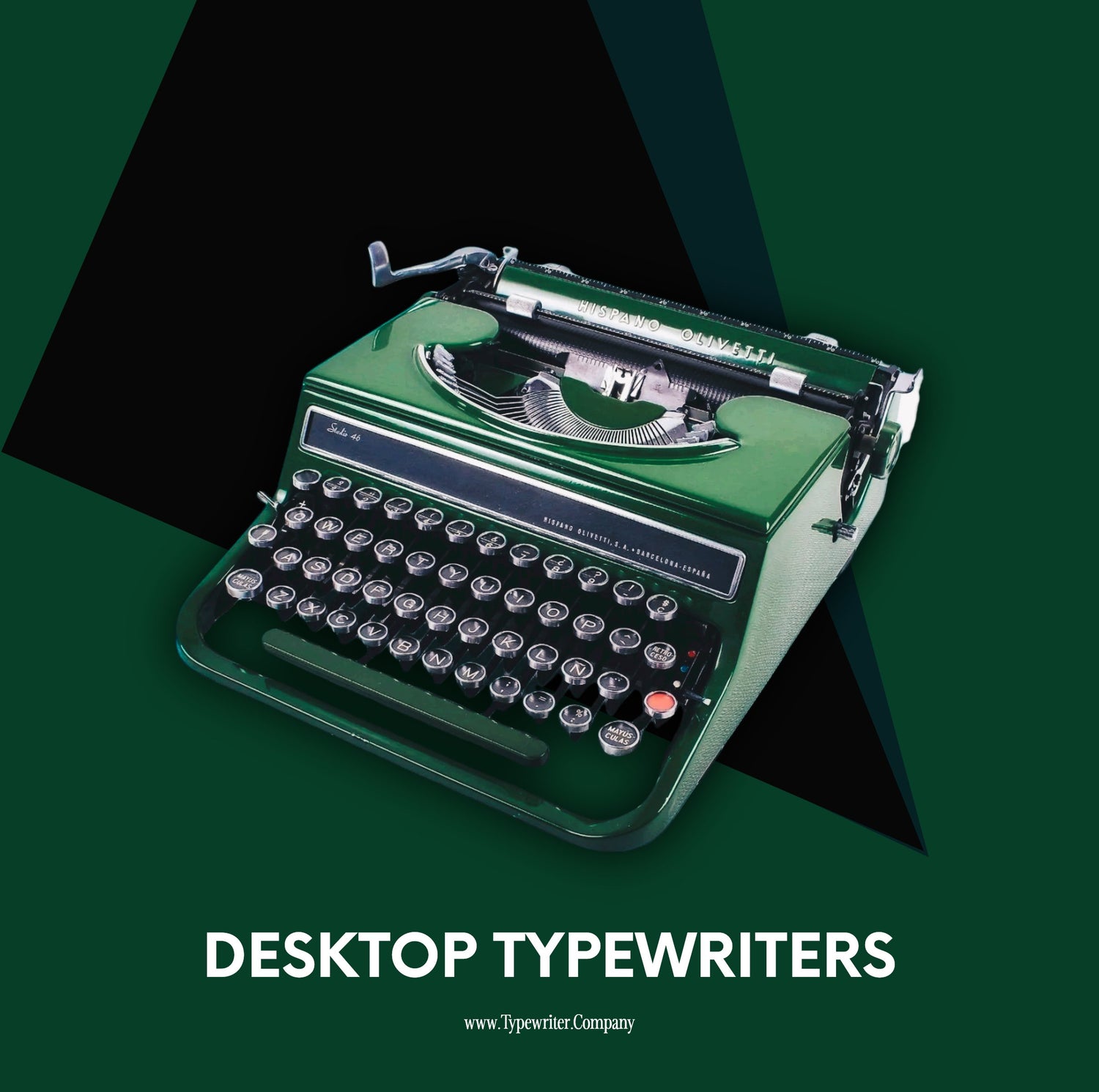
DESKTOP TYPEWRITERS
Desktop Typewriters Discover our exclusive collection of desktop typewriters, where classic elegance...
-
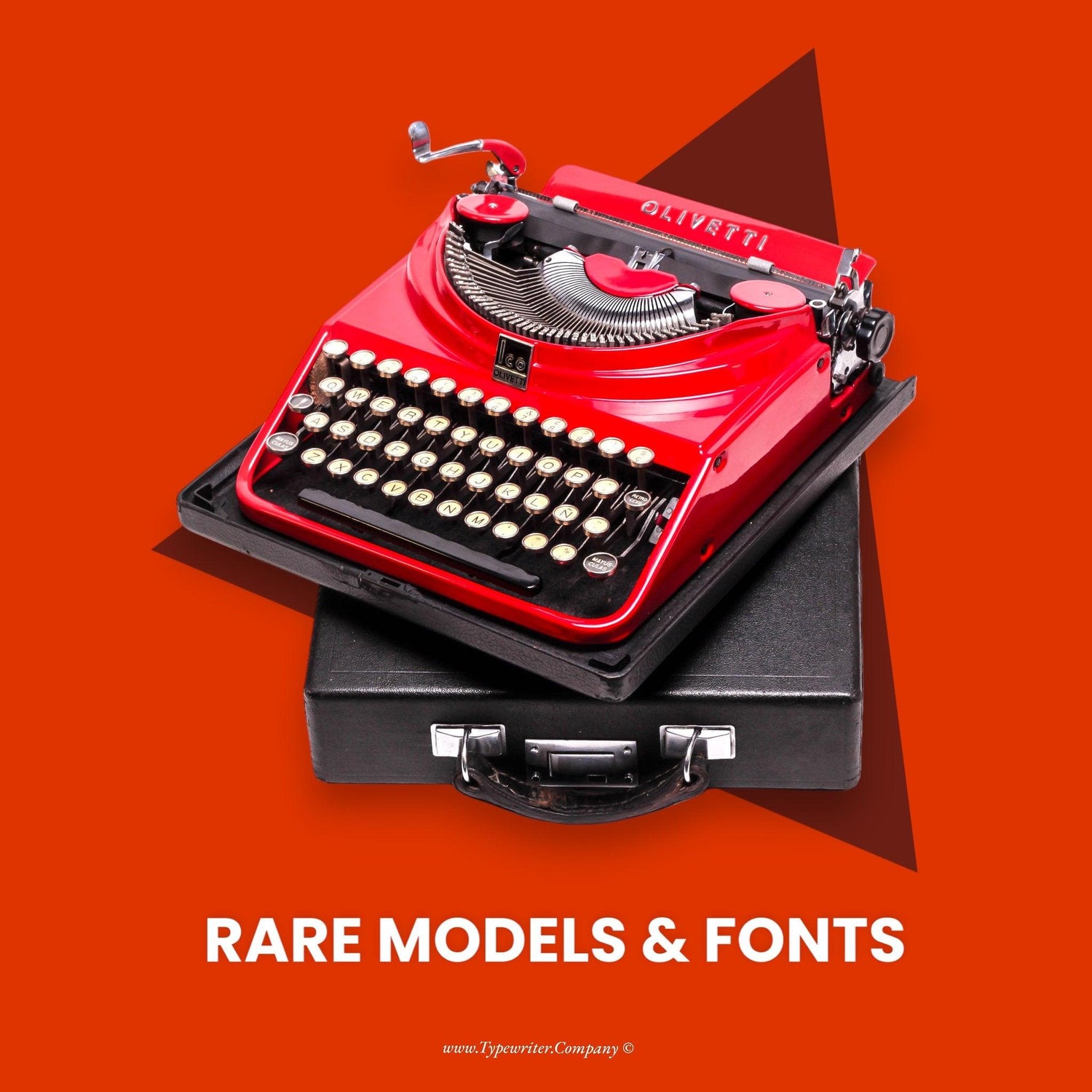
RARE TYPEWRITER MODELS & FONTS
Rare Typewriter Models & Fonts Explore our exclusive collection of rare typewriter...
-
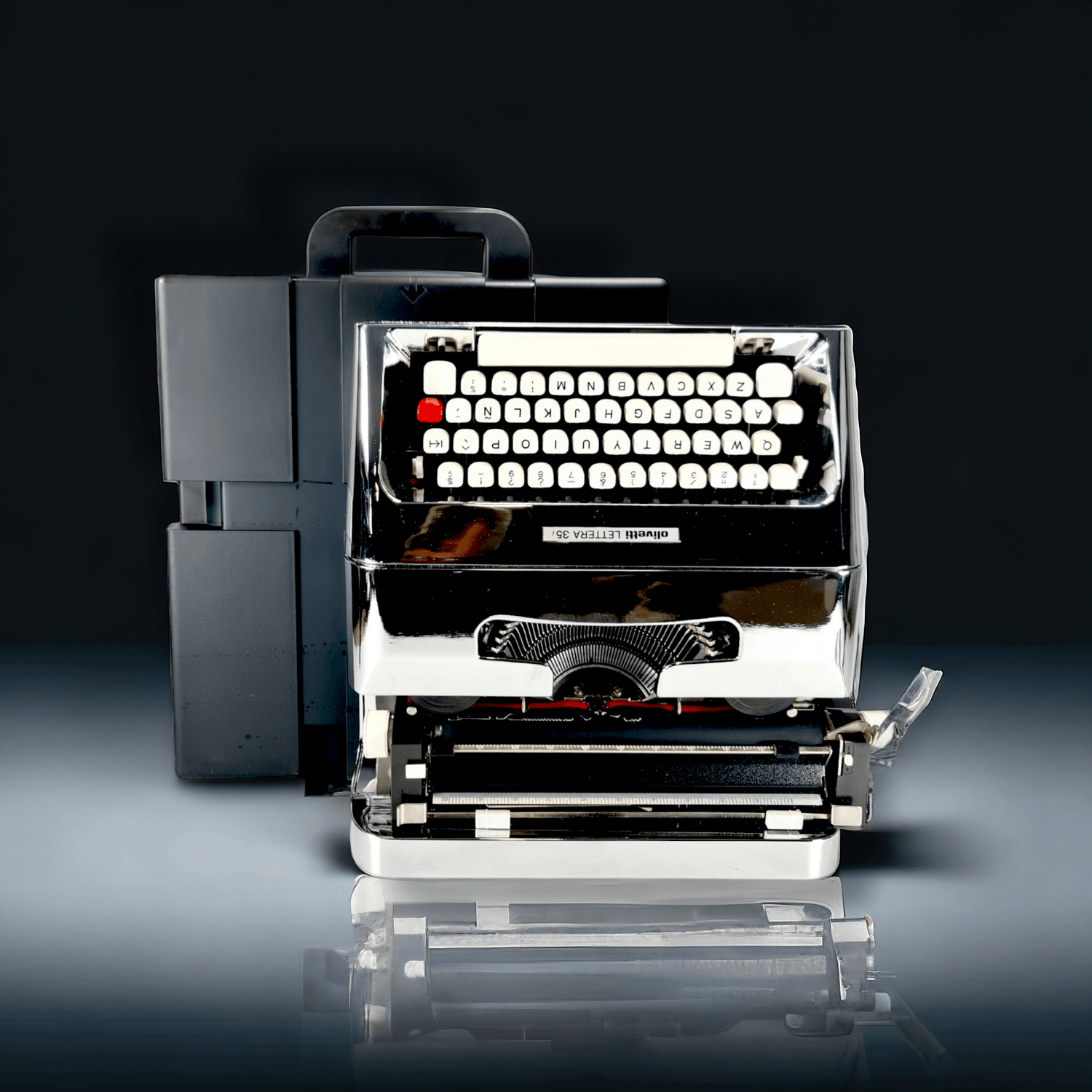
ICONIC OLIVETTI TYPEWRITERS
ICONIC OLIVETTI TYPEWRITERS Discover the charm and character of our curated Iconic...
-
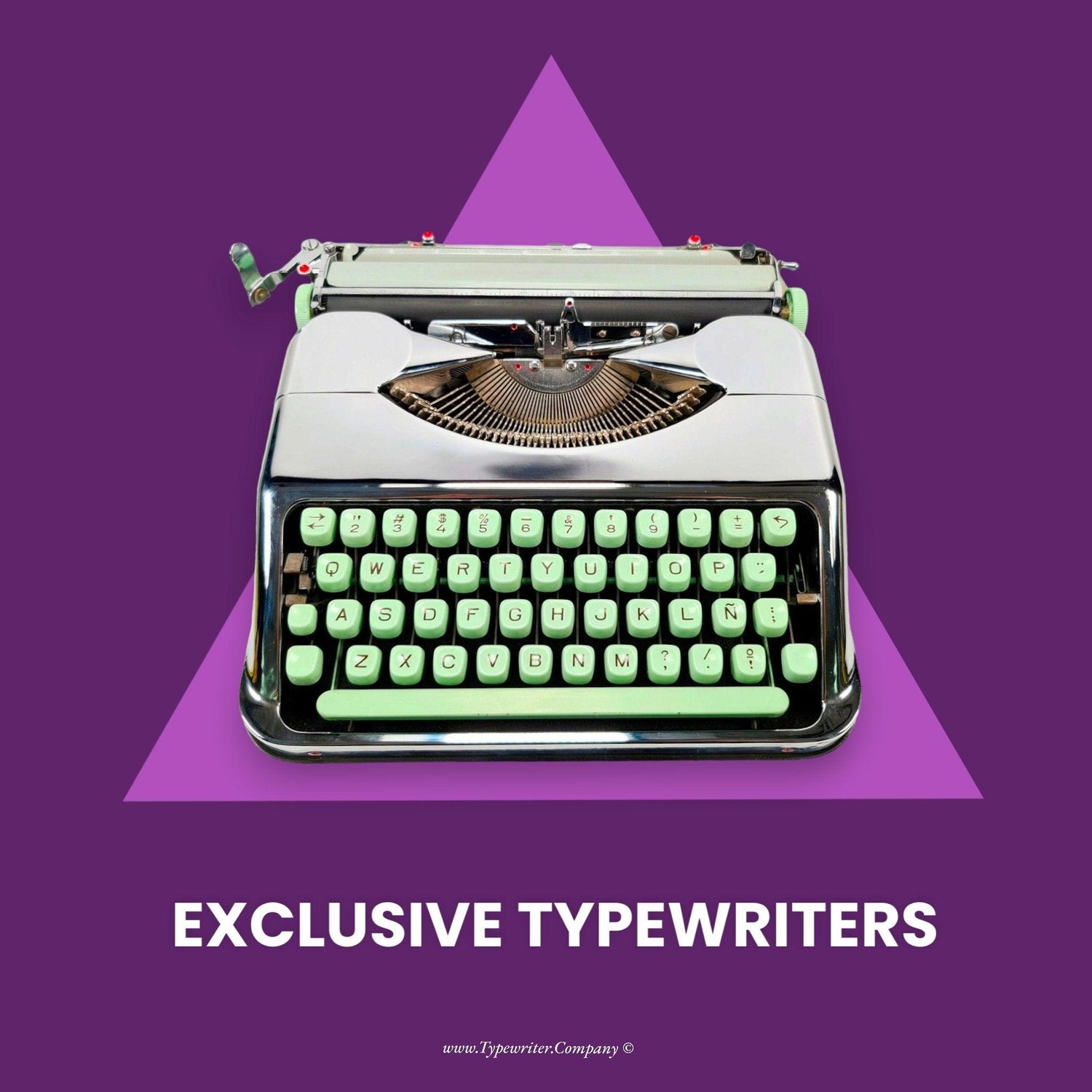
EXCLUSIVE TYPEWRITERS
Exclusive Typewriters Discover our exclusive typewriters, including chrome-plated, professionally painted, and rare...
OUTLET
Discover our curated outlet collection featuring classic typewriters from top brands, all at discounted prices up to 50% off. Whether you're a writer, collector, or vintage enthusiast, our outlet is the perfect place to find a reliable typewriter without breaking the bank.
-
Adler Contessa DeLuxe Typewriter, Portable Vintage QWERTY Typewriter
Regular price €200,00Regular priceUnit price / per€400,00Sale price €200,00Sold out -
Antares Compact Typewriter, QWERTY working vintage typewriter
Regular price €125,00Regular priceUnit price / per€250,00Sale price €125,00Sale -
Adler Tippa S, Burgundy Manual Vintage Typewriter, QWERTZ, Serviced
Regular price €210,00Regular priceUnit price / per€420,00Sale price €210,00Sale -
Triumph Contessa, Green Manual Vintage Typewriter, AZERTY, Serviced
Regular price €195,00Regular priceUnit price / per€390,00Sale price €195,00Sale -
Olivetti Studio 46 Typewriter, Vintage Manual, Refurbished, QWERTY Keyboard
Regular price €160,00Regular priceUnit price / per€320,00Sale price €160,00Sale -
Nippo P-200 Manual Vintage Typewriter, Serviced, Qwerty Keyboard
Regular price €145,00Regular priceUnit price / per€290,00Sale price €145,00Sale -
Olympia Traveller De Luxe Manual Vintage Typewriter, Portable, Serviced
Regular price €135,00Regular priceUnit price / per€270,00Sale price €135,00Sale -
Erika Daro mod.32, Light Gray&Blue Manual Vintage Typewriter, Serviced
Regular price €145,00Regular priceUnit price / per€290,00Sale price €145,00Sold out -
Olympiette DeLuxe, Gray Manual Vintage Typewriter, Serviced
Regular price €145,00Regular priceUnit price / per€280,00Sale price €145,00Sale -
Olivetti Lettera 35, Gray Manual Vintage Typewriter, Restored
5.0 / 5.0
(1) 1 total reviews
Regular price €195,00Regular priceUnit price / per€390,00Sale price €195,00Sale -
Olivetti Lettera 25 Beige, Vintage Manual Typewriter, Serviced
5.0 / 5.0
(1) 1 total reviews
Regular price €130,00Regular priceUnit price / per€260,00Sale price €130,00Sale -
Hispano Olivetti Ashtray, Square, Lexicon 80, Collector's Item
Regular price €40,00Regular priceUnit price / per€80,00Sale price €40,00Sold out -
Hispano Olivetti Ashtray, Triangle, Lexicon 80, 1950s, Collector's Item
Regular price €45,00Regular priceUnit price / per€90,00Sale price €45,00Sold out -
Olivetti Studio De Luxe, Blue&Grey Manual Vintage Typewriter, Serviced
Regular price €195,00Regular priceUnit price / per€390,00Sale price €195,00Sale -
Olivetti Lettera 35 Beige, Vintage Manual Typewriter, Restored
5.0 / 5.0
(3) 3 total reviews
Regular price €190,00Regular priceUnit price / per€380,00Sale price €190,00Sale -
Olympia Traveller Beige, Vintage Manual Typewriter, Restored
5.0 / 5.0
(2) 2 total reviews
Regular price €140,00Regular priceUnit price / per€280,00Sale price €140,00Sale -
Olivetti Studio 46 Blue, Vintage Manual Typewriter, Restored
5.0 / 5.0
(5) 5 total reviews
Regular price €195,00Regular priceUnit price / per€390,00Sale price €195,00Sale -
Olivetti Dora Gray, Vintage Manual Typewriter, Refurbished
5.0 / 5.0
(2) 2 total reviews
Regular price €130,00Regular priceUnit price / per€260,00Sale price €130,00Sale -
Hermes Baby Gray, Vintage Manual Typewriter, Restored
Regular price €200,00Regular priceUnit price / per€400,00Sale price €200,00Sale -
Olympiette Deluxe White, Vintage Manual Typewriter, Restored
Regular price €130,00Regular priceUnit price / per€260,00Sale price €130,00Sale
Perfect Typewriter
The Client's Choice! ✪✪✪✪✪
The Olivetti Lettera 32 is a piece of history. Released in 1963 and masterfully designed by the renowned Mario Bellini. Exceptional portable mechanical typewriter embodies the robustness and professionalism of an era when precision and craftsmanship were paramount.


PRO Serviced - 2 Years Warranty
El Granero Typewriter.Company
Olivetti Lettera 32 Original Green Vintage Manual Typewriter Serviced
Share








My Olivetti typewriter was delayed in shipping (through no fault of the seller) but when it arrived it was expertly packaged for shipping and arrived in excellent condition. When I contacted the seller about the delay in its arrival, the customer service immediately contacted the shipper and they were able to give me an updated estimate on the arrival date.
The typewriter is beautiful and fun to use.
I have always wanted a good typewriter in my adult life, and I have found one. The quality of the typewriter is superb. You wouldn't think it had been reconditioned. I am over the moon with it. If I should ever need another I shall definitely be shopping here.
FEATURED COLLECTION
-
Royal Quiet, Very Rare Font and Colour, Vintage Manual Typewriter Serviced
Regular price €3.200,00Regular priceUnit price / per€3.200,00Sale price €3.200,00 -
Adler Gabrielle 20 Manual Vintage Typewriter, QWERTY, Refurbished
Regular price €400,00Regular priceUnit price / per -
Hermes Baby Grey Manual Vintage Typewriter, Portable, Refurbished
Regular price €450,00Regular priceUnit price / per -
Underwood 319E, Vintage Manual Typewriter, Refurbished
Regular price €325,00Regular priceUnit price / per -
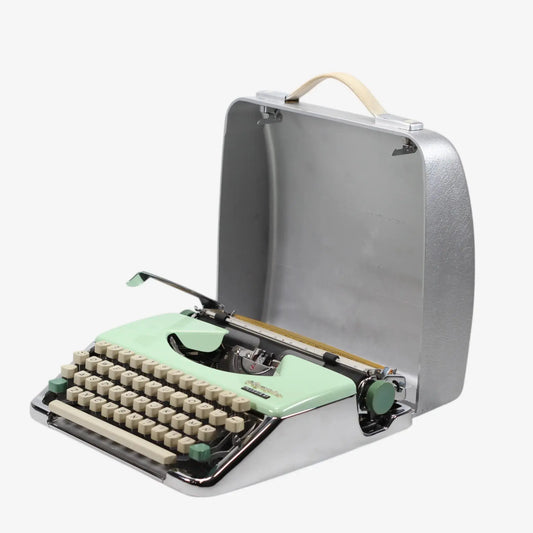
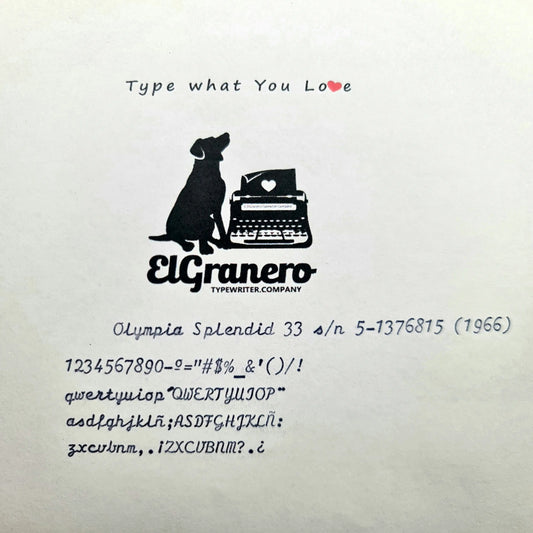
SOLD! Cursive Font! Chrome Plated! Olympia Splendid Vintage Manual Typewriter, Green, Restored
Regular price €0,00Regular priceUnit price / per -
Olympia Splendid Vintage Manual Typewriter, Silver, Green, QWERTY, Restored
Regular price €1.050,00Regular priceUnit price / per -
Hermes Media 3 Seafoam Green, Vintage Manual Typewriter, Serviced
Regular price €950,00Regular priceUnit price / per -
Electric Typewriter CasioWriter CW-11, Vintage
5.0 / 5.0
(1) 1 total reviews
Regular price €390,00Regular priceUnit price / per€195,00Sale price €390,00 -
Olympia Splendid Vintage Typewriter, Chrome-Plated, QWERTY Keyboard, Restored
Regular price €1.050,00Regular priceUnit price / per -
Erika 5 Gold, Rare Manual Vintage Typewriter, Professionally Serviced
Regular price €1.170,00Regular priceUnit price / per -
Olivetti Lettera 35 Typewriter, Red, Vintage, Manual, Restored
Regular price €420,00Regular priceUnit price / per -
Olivetti Lettera 35 Black and Green Manual Vintage Typewriter Restored
Regular price €520,00Regular priceUnit price / per -
Olivetti Lettera 32 Black Manual Vintage Typewriter, Restored
Regular price €390,00Regular priceUnit price / per -
Olivetti Lettera 32, Yellow Manual Vintage Typewriter, Restored
5.0 / 5.0
(2) 2 total reviews
Regular price €390,00Regular priceUnit price / per -
Olivetti Valentine S, Red Manual Vintage Typewriter, Serviced
Regular price €520,00Regular priceUnit price / per -
Olivetti Dora, Black Portable Manual Vintage Typewriter, Restored
4.67 / 5.0
(6) 6 total reviews
Regular price €360,00Regular priceUnit price / per -
Olivetti Lettera 35 Matte Black, Manual Vintage Typewriter, Restored
Regular price €455,00Regular priceUnit price / per -
Olivetti Studio 45 Turquoise Vintage Manual Typewriter, Serviced
5.0 / 5.0
(13) 13 total reviews
Regular price €390,00Regular priceUnit price / per -
Iconic Olivetti Lettera 35 Yellow Vintage, Manual Typewriter, Restored
5.0 / 5.0
(6) 6 total reviews
Regular price €450,00Regular priceUnit price / per -
Olympia Traveller Cherry Red Vintage Manual Typewriter, Restored
5.0 / 5.0
(6) 6 total reviews
Regular price €325,00Regular priceUnit price / per
SPOOLS & RIBBONS
-
Yellow Universal Metal Ribbon Spools for Typewriters
Regular price €50,00Regular priceUnit price / per -
Red/ Black Metal Universal Ribbon Spools for Typewriters
Regular price €35,00Regular priceUnit price / per -
Turquoise Metal Universal Ribbon Spools for Typewriters
Regular price €50,00Regular priceUnit price / per -
Navy Blue Metal Universal Ribbon Spools for Typewriters
Regular price €50,00Regular priceUnit price / per -
Burgundy Metal Universal Ribbon Spools for Typewriters
Regular price €50,00Regular priceUnit price / per -
Yellow Vintage Metal Ribbon Spools for Hermes Typewriters
Regular price €65,00Regular priceUnit price / per -
Red Silver Metal Ribbon Spools for Hermes Typewriters
Regular price €120,00Regular priceUnit price / per -
Chrome-Plated Silver Metal Ribbon Spools, German Typewriters, DIN 2103
Regular price €110,00Regular priceUnit price / per
DUST COVERS
-
SMALL Transparent Typewriter Dust Cover for Olivetti Lettera 32 / 22
4.92 / 5.0
(12) 12 total reviews
Regular price From €45,00Regular priceUnit price / per -
MEDIUM Typewriter Dust Cover for Olivetti Studio 44, Transparent
5.0 / 5.0
(4) 4 total reviews
Regular price From €52,00Regular priceUnit price / per -
XL Transparent Typewriter Dust Cover for Olivetti Linea 98 Typewriter
5.0 / 5.0
(3) 3 total reviews
Regular price From €80,00Regular priceUnit price / per -
MEDIUM Typewriter Dust Cover for Olympia SM, Monica, Transparent
Regular price From €52,00Regular priceUnit price / per -
MEDIUM Transparent Typewriter Dust Cover for Hermes 3000 (round top)
Regular price From €52,00Regular priceUnit price / per -
Typewriter Dust Cover Transparent Dust Cover for Hermes Baby / Rocket Typewriter
5.0 / 5.0
(1) 1 total reviews
Regular price From €45,00Regular priceUnit price / per -
MEDIUM Typewriter Dust Cover for Olivetti Lettera 35/35i Typewriter
5.0 / 5.0
(3) 3 total reviews
Regular price From €52,00Regular priceUnit price / per -
OUTLET XL Transparent Typewriter Dust Cover for a Standard Typewriter
Regular price €25,00Regular priceUnit price / per€80,00Sale price €25,00Sale
Blog [One Keystroke at a Time] - New Post!
View all-
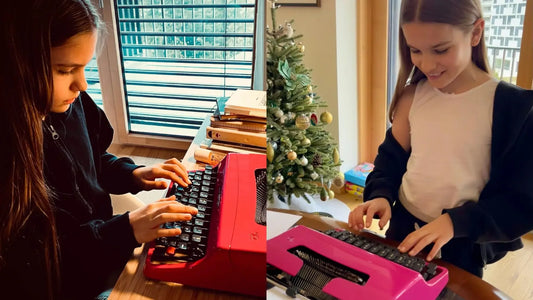
The Magic of Typewriters: A Young Writer’s Pers...
In this post, we share the inspiring story of Louise, a 12-year-old passionate about dance and storytelling. Louise explains why she prefers using a typewriter over a computer for her...
The Magic of Typewriters: A Young Writer’s Pers...
In this post, we share the inspiring story of Louise, a 12-year-old passionate about dance and storytelling. Louise explains why she prefers using a typewriter over a computer for her...
-
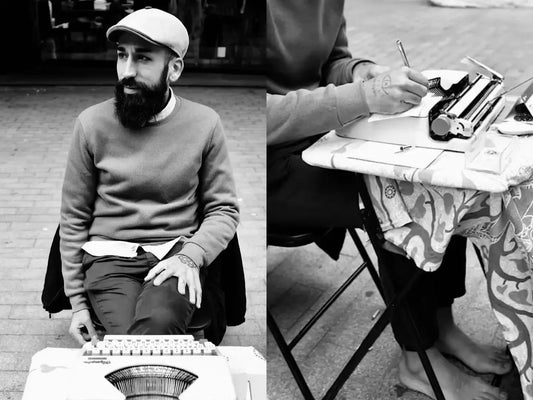
Interview with Darío Peinado, Spain’s Wandering...
Interview with Darío Peinado, Spain’s Wandering Street Poet. Poetry for Strangers - Barefoot Verses Darío Peinado is no typical poet. Barefoot and unburdened, he roams Spain’s streets with only his...
1 commentInterview with Darío Peinado, Spain’s Wandering...
Interview with Darío Peinado, Spain’s Wandering Street Poet. Poetry for Strangers - Barefoot Verses Darío Peinado is no typical poet. Barefoot and unburdened, he roams Spain’s streets with only his...
1 comment -

The Haiku of the Typewriter.
Why, in an era dominated by digital word processors, would a typewriter once the emblem of creative freedom serve as the perfect tool for composing haiku?
3 commentsThe Haiku of the Typewriter.
Why, in an era dominated by digital word processors, would a typewriter once the emblem of creative freedom serve as the perfect tool for composing haiku?
3 comments -

Will the revolution be typewritten?
In a world where shortcuts, memes, and poor language have become the norm, the typewritten page stands as a bulwark against the erosion of meaningful expression...
3 commentsWill the revolution be typewritten?
In a world where shortcuts, memes, and poor language have become the norm, the typewritten page stands as a bulwark against the erosion of meaningful expression...
3 comments
Typewriter Quick Care Checklist

Keep it Covered
Store your typewriter in its case or under a dust cover when not in use. Avoid damp and sunny areas. Store your machine in a dry, environment with stable temperature and humidity.
Clean Regularly
Use a soft brush or compressed air to eliminate dust between keys and inside mechanisms. Having cats or dogs? Cover it at all times to prevent extra cleaning ;)
Wipe the Exterior
Use a soft, slightly damp cloth to remove smudges and fingerprints; avoid harsh cleaners. Avoid aggressive liquids as they can harm varnish, paint, or plastic elements.
Lubricate Sparingly
Apply a drop of lightweight oil (like Liquid Bearings) only to pivot points and never over-oil.
Replace Ribbon
Change ribbons every few months or when prints start to fade. If letters start to fade quicker, just check the spool's movement to see if everything works fine. Maybe it is the direction lever or something that is stuck.
Handle Carriage Gently
Return the carriage smoothly; avoid slamming to prevent damage. Handle the carriage with care during the return process to maintain its functionality and appearance. Be gentle, it is your best writing companion.
Release Roller Tension
Never leave paper clamped in the platen for long periods; release the rollers' tension before storage. Proper care for your platen includes releasing the rollers' tension before storing your typewriter.
Use It Regularly
Write a lot! At least create small notes, one or two poems to fill an A4 page each month to power the machine; typewriters run smoothly without lubrication. Consistent writing ensures elite performance and enduring strength.
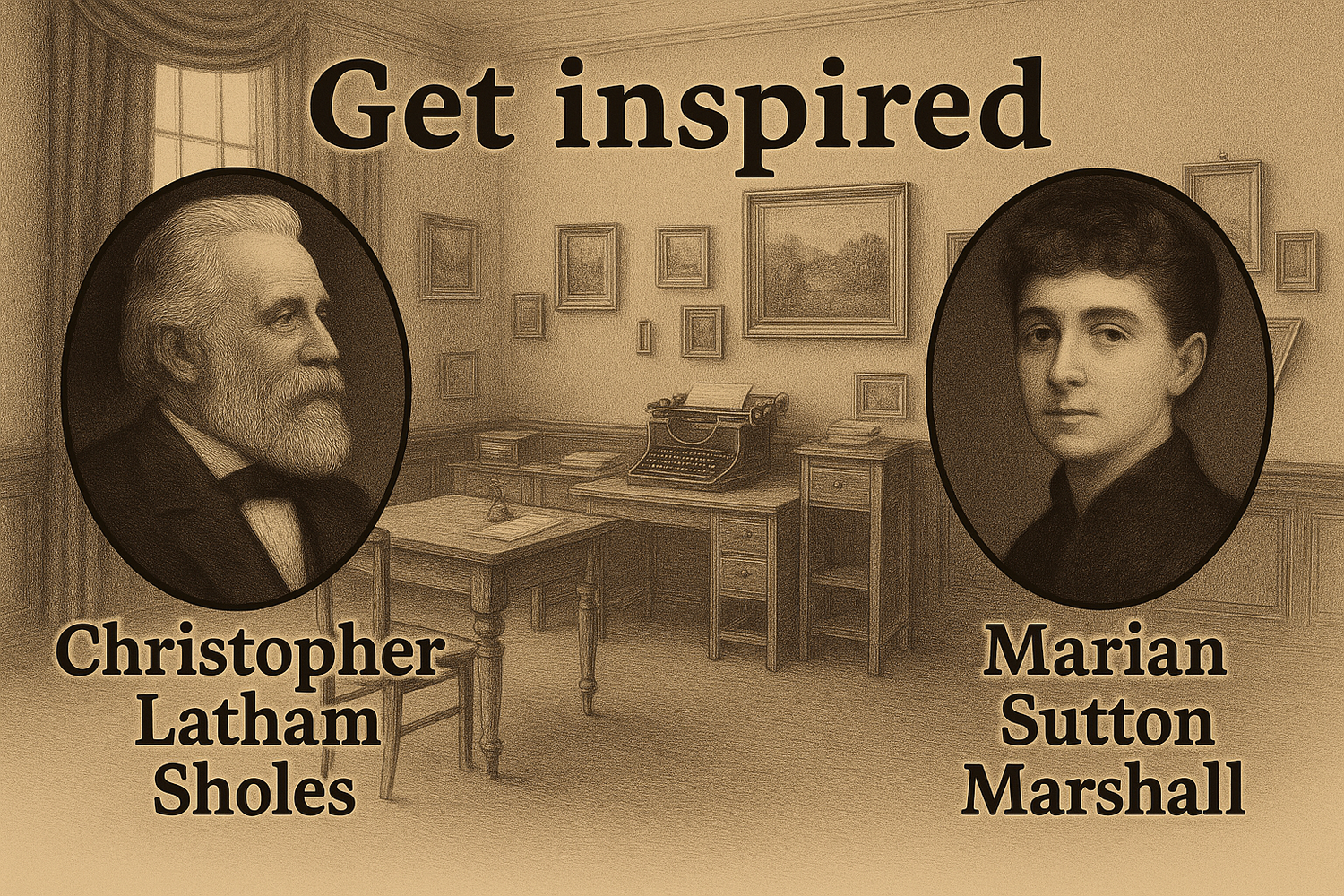
TYPEWRITERS
Discover fascinating facts about typewriters from their revolutionary invention to their enduring legacy in a digital age. Learn about iconic models and quirky anecdotes that shape our world. Explore the evolution of typewriter technology and its impact on communication throughout history.
The Origin of the Typewriter Revolution
-
Who and when invented the first Typewriter?
Long ago, in Milwaukee, Wisconsin, lived a curious inventor named Christopher Latham Sholes (born 1819). He started as a printer and newspaper editor, and he loved inventing machines.
At first, Sholes built a machine to number pages and tickets. But his friends Samuel Soule and Carlos Glidden suggested, ‘What if it could print letters instead?’ So in 1866–67 they began experimenting.
With a few rough models and feedback from testers, they improved the design. In June 1868, they received a patent for their typewriting machine (US 79,265). It became the first practically useful and commercially sold typewriter in the 1870s, after being acquired and marketed by Remington. -
Ever wondered why keyboards start with Q‑W‑E‑R‑T‑Y?
Sholes, along with partner James Densmore, faced the problem of type bar jamming. To address this, Sholes strategically spaced out commonly used letters, leading to the QWERTY layout that is still prevalent today.
At first, people thought typewritten letters looked cold or impersonal, plus they were all uppercase! But soon, businesses and writers loved the speed and clarity.
The typewriter even gave many people, especially, new job opportunities as typists.
Thanks to Sholes and his friends, we can now support you in creating your own stories. Opt for typewriters, not screens—press each key, see your words come alive. Conceivably, one day, you might achieve fame as a novelist by utilising a typewriter as well. -
Who led the way, and how did it change our society?
Some women took typing further: like Marian Sutton Marshall, who opened one of the first ladies‑only typing offices in London and later founded a typists’ union!
Marshall organised and trained female typists and advocated for their rights
With more women typing, offices changed. They could support families, write creatively (hello, future novelists!), and challenge the idea that women belonged only at home. Marshall's efforts paved the way for greater opportunities for women in the typing profession.
Clerical work offered new economic roles and public identities for women across the U.S, UK across and Europe.

Let customers speak for us
from 571 reviews
Ania has been super helpful right from the start. She provided a wealth of information on typewriters, answering all my queries with patience.
The packaging for the shipping was super secure. I highly recommend The Typerwriter Company!

Great design, perfect function. Looked a while for this one and am happy now to write on it. Inspires me. Thanks to the work of typewriter/co.! Meinrad Braun

We. Are. Obsessed! The customer service, the extra care and thought put into it because it was a surprise/gift was unexpected. Not only that, it came very well packaged, and with a manual copy and everything! We love it so very much, thank you thank you! Now we just need to figure out a name for it <3

My Olivetti typewriter was delayed in shipping (through no fault of the seller) but when it arrived it was expertly packaged for shipping and arrived in excellent condition. When I contacted the seller about the delay in its arrival, the customer service immediately contacted the shipper and they were able to give me an updated estimate on the arrival date.
The typewriter is beautiful and fun to use.

One of the most amazing sellers I have ever worked with they packaged amazingly and made it so special for my wife birthday thank you so much would recommend to anyone looking for an amazing seller

This is an absolutely stunning typewriter! It is in excellent condition, and the sellers included a Tolkien quote and a cute typewriter pin! It comes with an instruction manual, which was helpful as this is my first typewriter.
The shipping to the USA took approximately 1.5 months longer than predicted. I don't blame the sellers for this, as they posted the typewriter in the post VERY quickly. The wait was worth it. Fortunately this typewriter just for personal use - if purchased as a gift, buy VERY early.
The only bummer was the installed typewriter ribbon being almost completely dried out - I purchased a new typewriter ribbon today but am sad that I can't use my typewriter until it arrives.
The sellers are AMAZING. They have been very helpful and kind. This is the only shop I'd consider for purchasing a typewriter.

Anita and Jacek were determined to make sure the typewriter arrived safely, and they took the time to call and troubleshoot some shilling issues. When the typewriter finally arrived, it was everything I hoped it would be. It was in beautiful condition and worked like a dream. I can't wait to get full use out of it!

This typewriter is absolutely amazing and it was immaculately packed. There were some issues with fed ex but it was nothing to do with the seller. The sellers are very kind and patient and had no problems accommodating me and kept me updated all of the way!

Great for my IBM Selectric Model 72 on my desk. Keeps it dust free while displaying it beautifully, perfectly clear heavy duty vinyl, nicely stitched seams with a black bottom border, very high quality!

This is my first Hermes Baby, It is in good condition it is clean and pretty ! really an ultraportable one ,ready to use .Thanks to Ania of El Granero for keeping track of the shipment ,for packing it securely and giving an additonal extra touch of wrapping in time for Christmas .I really appreciate it .Of course for the wonderful cute typweriter Pin and dust cover freebies ! 😍😍

I have always wanted a good typewriter in my adult life, and I have found one. The quality of the typewriter is superb. You wouldn't think it had been reconditioned. I am over the moon with it. If I should ever need another I shall definitely be shopping here.

I received my yellow Olympia Monica typewriter this week and I have to say I was very pleasantly surprised with the quality of the work of El Granero. The machine was perfectly packed and it arrived in perfect condition after its long trip from Malaga, Spain to Georgia in the US.
The machine looks almost brand new and it works flawlessly, which is amazing considering it is more than 50 years old.
I would definitely buy from El Granero again, and I will highly recommend them to anyone looking to purchase a vintage typewriter.
Thank you, Ania and Jacek for the amazing work you do!

The typewriter came in amazing packaging to ensure as much care during the shipping process as possible. A few issues with shipping occurred, but Ania was always so helpful and went above and beyond to fix the issue. I am very happy with my purchase and would buy from Ania and Jacek again!

Type writer is beautiful and arrived after nearly 2 months. If you're looking to purchase it asap, do not expect it to arrive quickly as it does get cleaned and refurbished first, then it gets sent out. Also, due to it being summer, delivery services are slower. Sellers were kind and kept me updated throughout the process. It is definitely one of those situations where you ask, 'Is it worth the wait?' It makes a great addition to my room.
This review has no content.







